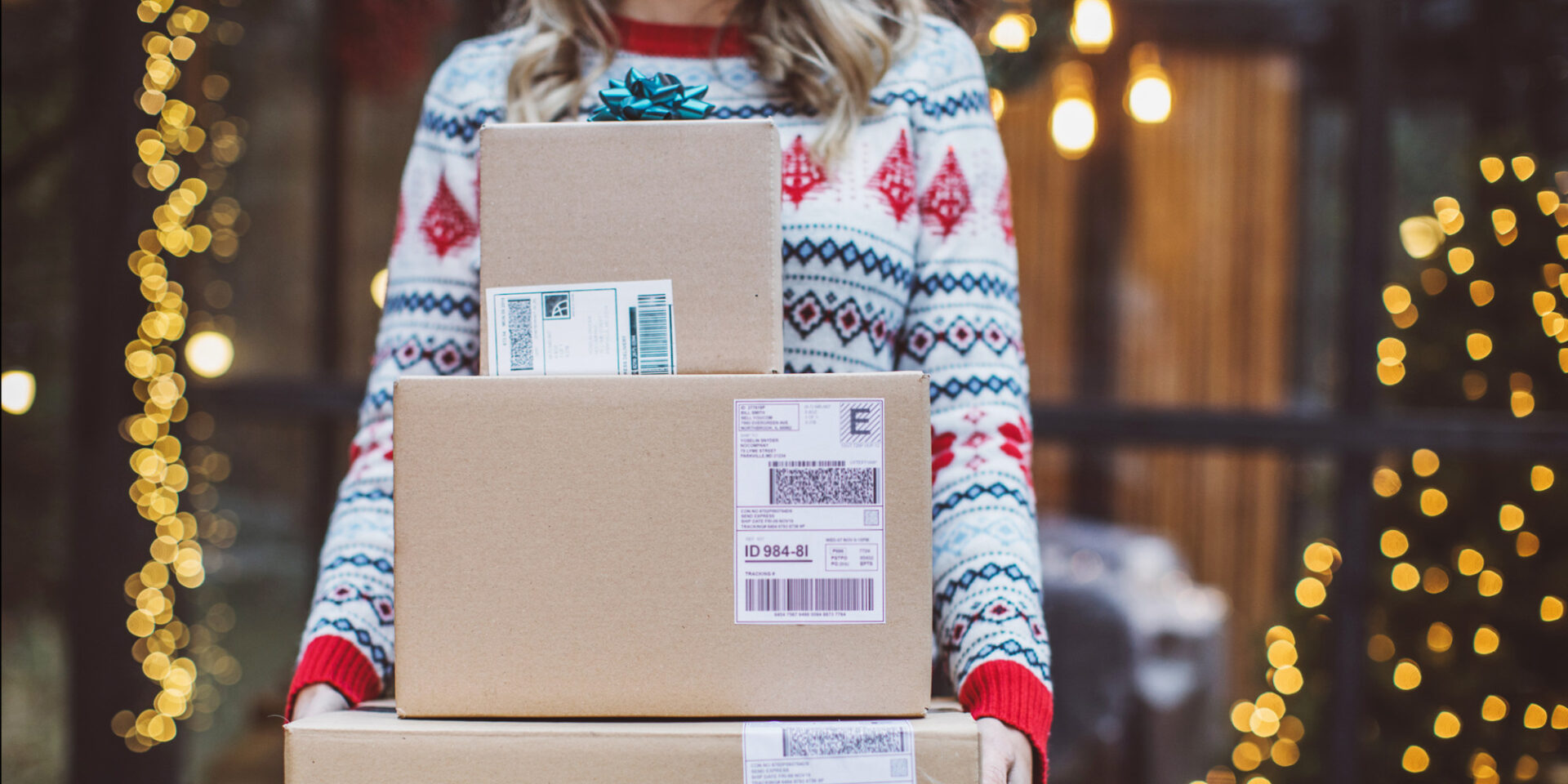
Articles | October 8, 2021 | 4 min read
Unwrapping the Biggest Holiday Retail Trends of 2021
‘Tis the season of giving and retailers are eagerly anticipating a +7% YoY increase in sales between November and December alone.
To make the most of this key consumer spending period, brands must adapt to the supply chain/inventory shake-up as well as the evolving digital customer journey. Packed with predictions, this article aims to give you insight into the trends expected to shape the biggest retail event of the year.
As supply chain complications loom this holiday, consumers are shopping earlier to ensure they get the top products on their lists. Moreover, the December 15 cutoff date for ground delivery set by USPS, FedEx, and UPS will prompt consumers to hit the stores and browse online to get what they need in a more timely fashion.

But even with all of the early shopping happening, there’s still the question of ‘how is it going to be delivered?’ Retailers will be reliant on independent delivery teams within popular DMAs to avoid late deliveries, being more relevant with communications as it relates to in-stock/out-of-stock inventory.
Despite a lot of shopping happening online this year, 45% of people are still looking for hybrid or in-store shopping experiences that are convenient to their shopping needs. Retailers will be looking to double up on their product offering with Pop-up and shop-in-shops (e.g. Target’s shop-in shop with Disney). By introducing merchandise they may not otherwise have access to, brands will be able to increase foot traffic and help customers turn a ten-stop shopping event into five. It’s a win/win situation.

The success of a retailer’s pop-up or shop-in shop will be reliant on partnering with a brand that doesn’t compete with their current offering. This will be a built-out experience in an existing store or via excess real estate in a new test market. To tie the bow on top, retailers will connect in-store offerings to an ecommerce storefront to promote partnerships and enable consumers to jump to various online marketplaces.
Livestream selling, also known as the modern-day QVC, will help humanize the online shopping experience and generate excitement for specific product categories by leveraging social media-savvy associates and influencers. This will enable retailers to generate new lines of revenue and make way for new inventory by showcasing products from categories that were overbought in. Moreover, it will be a pivotal tactic to help reach anxious consumers concerned about shopping in-store due to the COVID-19 Delta variant.

The brands that will win with livestream selling will have tested timeframes to get an understanding of when their audience is most engaged (e.g. early mornings versus afternoon versus post-dinner, etc.), and activate across multiple social channels including YouTube, Instagram Live, Facebook, and TikTok.
Gift guides are imperative this year after a boom in ecommerce shopping and online product discovery in 2020. In fact, a recent study reveals that 63% of shoppers now enjoy discovering items they weren’t actively looking for.
Curating gift guides is in every retailer’s nature, but oftentimes these guides turn into overly promoting excess or old inventory. This holiday season, retailers will be replacing their top 10 gift guides with individualized guides for customers using proprietary customer data (e.g. purchase history, interests, website behavior, etc.). This will ensure customers are seeing the products they’re most interested in and in turn increase their purchase intent.

Despite another round of child tax credits, many consumers are still holding on to their wallets this holiday season as a direct response to the pandemic. To afford shoppers the opportunity to buy a special gift for everyone on their list, retailers will be offering consumers the option to buy now and pay later with services such as Klarna and AfterPay.

As many as 30-40% of U.S. consumers continue to switch brands or retailers to those that place more emphasis on purpose-driven alignment. This holiday season, retailers will be promoting ‘hero’ products that have a deep content strategy related to a greater purpose attached to them (e.g., donating a portion of proceeds to charity, highlighting sustainable materials, partnering with local businesses, etc.). Hiring influencers (both well-known and everyday people) that are connected to these hero products to strengthen their promotion will be crucial, as well as linking back to one of this year’s trending categories — Luxury, Fashion, or Adventure.

Retail brands will also use virtual cart capabilities on their e-commerce site to make it easy for consumers to buy these purpose-driven products. This might be the ability to automatically charge the full amount to a card on file when an item comes back in stock, or charging a down payment and holding an item for a limited amount of time until the customer decides if they want it or not.
Looking for more tips and trends for the 2021 holiday season? Unwrap additional insights and learn how to win at the biggest shopping event in our holiday guide.
To make the most of this key consumer spending period, brands must adapt to the supply chain/inventory shake-up as well as the evolving digital customer journey. Packed with predictions, this article aims to give you insight into the trends expected to shape the biggest retail event of the year.
Early shopping events and independent delivery teams will help eliminate ‘Bah Humbug!’
As supply chain complications loom this holiday, consumers are shopping earlier to ensure they get the top products on their lists. Moreover, the December 15 cutoff date for ground delivery set by USPS, FedEx, and UPS will prompt consumers to hit the stores and browse online to get what they need in a more timely fashion.

(Image source: USA Today)
But even with all of the early shopping happening, there’s still the question of ‘how is it going to be delivered?’ Retailers will be reliant on independent delivery teams within popular DMAs to avoid late deliveries, being more relevant with communications as it relates to in-stock/out-of-stock inventory.
Pop-up and shop-in-shops will deck the halls to create convenience
Despite a lot of shopping happening online this year, 45% of people are still looking for hybrid or in-store shopping experiences that are convenient to their shopping needs. Retailers will be looking to double up on their product offering with Pop-up and shop-in-shops (e.g. Target’s shop-in shop with Disney). By introducing merchandise they may not otherwise have access to, brands will be able to increase foot traffic and help customers turn a ten-stop shopping event into five. It’s a win/win situation.

(Image source: Target)
The success of a retailer’s pop-up or shop-in shop will be reliant on partnering with a brand that doesn’t compete with their current offering. This will be a built-out experience in an existing store or via excess real estate in a new test market. To tie the bow on top, retailers will connect in-store offerings to an ecommerce storefront to promote partnerships and enable consumers to jump to various online marketplaces.
Livestream selling goes mainstream selling
Livestream selling, also known as the modern-day QVC, will help humanize the online shopping experience and generate excitement for specific product categories by leveraging social media-savvy associates and influencers. This will enable retailers to generate new lines of revenue and make way for new inventory by showcasing products from categories that were overbought in. Moreover, it will be a pivotal tactic to help reach anxious consumers concerned about shopping in-store due to the COVID-19 Delta variant.

(Image source: Bloomberg)
The brands that will win with livestream selling will have tested timeframes to get an understanding of when their audience is most engaged (e.g. early mornings versus afternoon versus post-dinner, etc.), and activate across multiple social channels including YouTube, Instagram Live, Facebook, and TikTok.
Personalized gift guides will bring good tidings
Gift guides are imperative this year after a boom in ecommerce shopping and online product discovery in 2020. In fact, a recent study reveals that 63% of shoppers now enjoy discovering items they weren’t actively looking for.
Curating gift guides is in every retailer’s nature, but oftentimes these guides turn into overly promoting excess or old inventory. This holiday season, retailers will be replacing their top 10 gift guides with individualized guides for customers using proprietary customer data (e.g. purchase history, interests, website behavior, etc.). This will ensure customers are seeing the products they’re most interested in and in turn increase their purchase intent.

‘Buy now, pay later’ options will be used to create comfort and joy
Despite another round of child tax credits, many consumers are still holding on to their wallets this holiday season as a direct response to the pandemic. To afford shoppers the opportunity to buy a special gift for everyone on their list, retailers will be offering consumers the option to buy now and pay later with services such as Klarna and AfterPay.

(Image source: Sensor Tower)
Purpose-driven ‘hero’ products will make spirits bright
As many as 30-40% of U.S. consumers continue to switch brands or retailers to those that place more emphasis on purpose-driven alignment. This holiday season, retailers will be promoting ‘hero’ products that have a deep content strategy related to a greater purpose attached to them (e.g., donating a portion of proceeds to charity, highlighting sustainable materials, partnering with local businesses, etc.). Hiring influencers (both well-known and everyday people) that are connected to these hero products to strengthen their promotion will be crucial, as well as linking back to one of this year’s trending categories — Luxury, Fashion, or Adventure.

(Image source: Freestocks)
Retail brands will also use virtual cart capabilities on their e-commerce site to make it easy for consumers to buy these purpose-driven products. This might be the ability to automatically charge the full amount to a card on file when an item comes back in stock, or charging a down payment and holding an item for a limited amount of time until the customer decides if they want it or not.
Give the gift of value this holiday season
Looking for more tips and trends for the 2021 holiday season? Unwrap additional insights and learn how to win at the biggest shopping event in our holiday guide.


